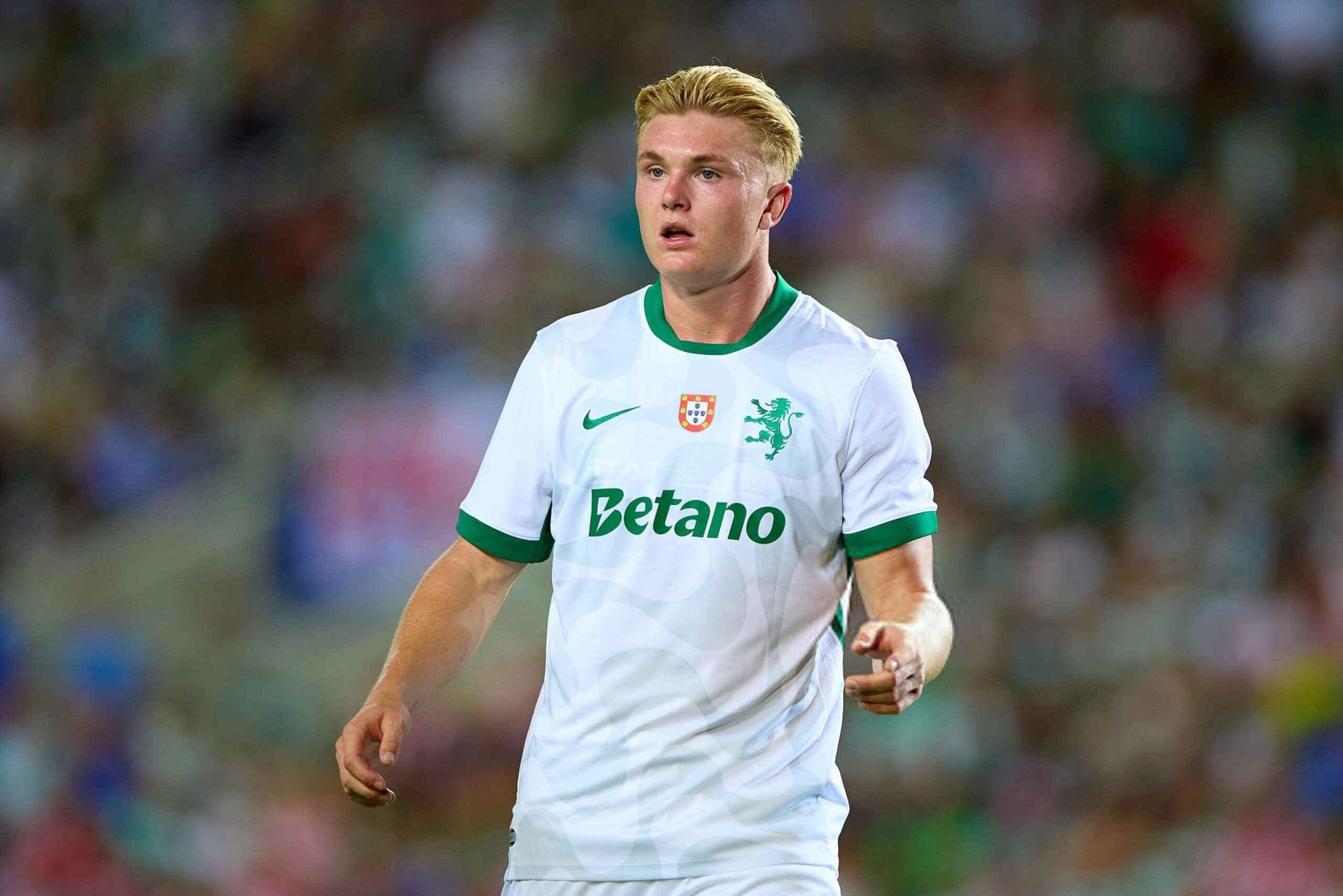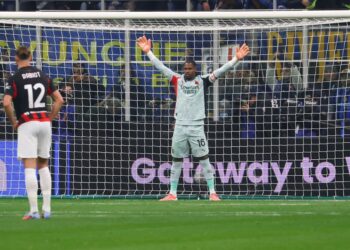AC Milan’s striker, Santiago Giménez, is definitely struggling to show that he could be Milan’s main striker, even though the Mexican had already been a dead man walking for months. Head coach Massimiliano Allegri and the new management immediately sidelined him, and the search for a new center-forward by the Rossoneri took almost the whole summer.
Towards the end, it seemed that Conrad Harder would be taking the central attack role. After failed attempts to approach Vlahović and the Boniface deal falling through after the medicals, Milan chose a profile still largely unexplored. In a sense, Harder would have been a more intriguing acquisition compared to both the Serbian and the Nigerian, two players whose strengths and weaknesses are already known. The Danish player, instead, has shown so little that Rossoneri fans, at best, are free to imagine his potential.
It is true that the talks failed in the last steps due to Sporting CP failing to secure his replacement, and also due to (reportedly) his agents asking to adjust the commission fees and salary. But in this article, we will dive deeper to study Conrad Harder's profile, and if he could be a suitable profile for the future in Milan.
Milan would have consoled themselves, in a worst case scenario, knowing that a 2005-born striker is unlikely to depreciate drastically, and that, all things considered, the 24 million euros plus 3 in bonuses reportedly involved in that deal initially may not be a bad investment, though it is a small comfort given the impatience of the Rossoneri fans toward a club accused of lacking the same ambition as the people it should represent.
With the betway app, AC Milan fans in Tanzania can stay connected to every match and place bets conveniently, whether tracking new striker Nkunku's movements on the pitch or following Leão’s explosive runs. The app offers a simple, intuitive interface to bet on live fixtures, top up accounts, and withdraw winnings securely and safely: all from a smartphone. For Rossoneri supporters who are keen to engage with the action beyond the stadium, the app ensures that no key moment goes unnoticed.
What are the technical motivations that made Milan think of signing Harder, before finally turning attention to Nkunku? How would Allegri have used him?
Observing the Dane for the first time, the most evident aspect of his game is that he is a striker full of energy. Standing 1.85 meters tall and possessing a strong physique, Harder is never still, he is explosive, tries to disturb defenders with his movements, and is not afraid to engage in duels. He is certainly an optimistic player, a fundamental quality for a striker, who never spares a run if he sees a chance to shoot. Such proactive spirit and above-average athletic skills must have convinced Milan to invest in him, as they probably convinced Sporting to acquire him from Nordsjælland, the club where he grew up (paying close to twenty million, not a small sum for a player who was still nineteen just a year ago).
The raw material exists and is of good quality. Additionally, Scandinavian players rarely disappoint in Serie A. However, Harder is still a striker in development, and we will see how our football will shape him.
Technically, his best quality is how he attacks space behind the defense. A natural left-footed player, he tends to open to his strong side—which is also Leão’s left—and attack the space between center-back and full-back to create vertical passing options. Harder’s runs represent a concrete danger for opposing defenses because he is fast, resists challenges, and has good ball control while running.
Milan’s midfield and attack are full of players who want to receive the ball at their feet. Adding a striker who constantly threatens space can only benefit the Rossoneri for several reasons. First, it provides a vertical outlet for the build-up: too often, Milan’s technical quality seemed to stagnate, without any movement to exploit it. Harder could represent an immediate option, the man to send forward as soon as a teammate raises his head.
Even if he does not receive the ball directly, the Dane could still be useful in other ways. His tendency to cut to the left, for example, could have been a great advantage for Leão, as the Dane would pull a man away and allow the Portuguese to drive forward with the ball more easily. Deep runs could stretch opponents and create the spaces in the attacking third necessary for more skilled teammates to express themselves.
Regarding his tendency to attack space, a consideration arises about Serie A defenders. Center-backs in our league are used to marking their opponent closely, giving their best when stepping forward and preventing the player from turning. But against opponents attacking on the flanks? In such situations, mobility issues of many Serie A defenders could emerge.
Lateral defending is harder for many Italian center-backs. By attacking space on a defender’s flank to call for vertical passes, Harder could be particularly uncomfortable for certain defenders used to defending in a forward-oriented manner. Combined with his physique and speed, he is not easy to challenge.
Pushed forward, the Dane does not hesitate, and his control is almost always aimed at shooting. Harder has decent shooting skills but sometimes overuses them. Statistics suggest Milan fans will have to get used to a striker who, to put it mildly, is not shy about attempting shots.
Despite limited playing time with Sporting CP (769 minutes total) and starting only six times last Portuguese season, he was still among the 30 players with the most shots: 27th with 45 attempts, and, as you can imagine, with the lowest minutes among the top 30. His average was 5.17 shots per 90 minutes, which made the quality of his shots rather low (0.07 xG per shot, the same as Krstović, known as Serie A’s most compulsive shooter).
Harder seems aware of this tendency, but his philosophy is similar to Michael Scott: not trying is wrong from the start. Asked if he intended to reduce his shooting volume, he replied categorically: “If I shot less, I would score less, therefore no. I will never remove this aspect from my game. It is part of me.”
In short, despite limited playing time, the type of striker Milan chose is clear. A direct, enterprising player who could have a strong athletic impact in Serie A. The Rossoneri will need to help him improve decision-making and refine technical skills.
In the penalty area, he has good instincts. Outside the box, he is not a player who hides but still has much to learn. He does not avoid using his right foot, but as a left-footer, he turns only to his left side. With his back to goal, he only makes simple passes and is not strong at orienting play. He does not fear contact with defenders, and Sporting even used him to receive long goal kicks, a trait that could be useful with Maignan’s distribution, as relayed via Italian outlet ultimouomo.com.
Harder is 20 years old with unquestionable potential. The question remains why Sporting did not bet on him after selling Gyökeres, instead signing 27-year-old Luis Suárez from Almería, who had a long career of loans in Spain and a failed season at Marseille, just before scoring 31 goals last season in Segunda. They did not try to develop him and now prefer to monetize; perhaps something about Harder did not convince them.
From the outside, we cannot answer that.
On paper, players with Harder’s characteristics can be very useful in Serie A, but how much time will the Dane need? That is difficult to say. Milan, however, needs immediate answers, and perhaps that is also one of the reasons they did not push any further for him and decided to sign Christopher Nkunku from Chelsea. But, in the transfer market, you never know what can happen: maybe Conrad Harder's path would lead him to AC Milan in the future...
















